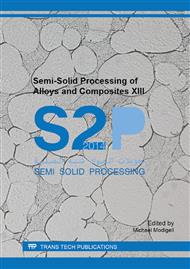[1]
Li, Z., A. M. Samuel, F. H. Samuel, C. Ravindran, S. Valtierra, and H. W. Doty. Parameters controlling the performance of AA319-type alloys: Part I. Tensile properties. Materials Science and Engineering: A 367, no. 1 (2004): 96-110.
DOI: 10.1016/j.msea.2003.09.090
Google Scholar
[2]
Mohamed, A. M. A., and F. H. Samuel. Influence of Mg and solution heat treatment on the occurrence of incipient melting in Al–Si–Cu–Mg cast alloys. Materials Science and Engineering: A 543 (2012): 22-34.
DOI: 10.1016/j.msea.2012.02.032
Google Scholar
[3]
Lise Dons, Anne. The Alstruc homogenization model for industrial aluminum alloys. Journal of Light Metals 1, no. 2 (2001): 133-149.
DOI: 10.1016/s1471-5317(01)00007-4
Google Scholar
[4]
Cerri, E., Evangelista, E., Spigarelli, et al, 2000. Effects of thermal treatments on microstructure and mechanical properties in a thixocast 319 aluminum alloy. Material Science and Engineering A Struct. 284, 254–260.
DOI: 10.1016/s0921-5093(00)00748-6
Google Scholar
[5]
Roy, N., A. M. Samuel, and F. H. Samuel. Porosity formation in Al-9 Wt Pct Si-3 Wt Pct Cu alloy systems: Metallographic observations. Metallurgical and Materials transactions A 27, no. 2 (1996): 415-429.
DOI: 10.1007/bf02648419
Google Scholar
[6]
Zhu, Qiang, Stephen P. Midson, Chang Wei Ming, and Helen V. Atkinson. Casting and Heat Treatment of Turbocharger Impellers Thixocast from Alloy 201. Solid State Phenomena 192 (2013): 556-561.
DOI: 10.4028/www.scientific.net/ssp.192-193.556
Google Scholar
[7]
Mohamed, A. M. A., A. M. Samuel, F. H. Samuel, and H. W. Doty. Influence of additives on the microstructure and tensile properties of near-eutectic Al–10. 8% Si cast alloy. Materials & Design 30, no. 10 (2009): 3943-3957.
DOI: 10.1016/j.matdes.2009.05.042
Google Scholar
[8]
Wang, G., Sun, Q., Feng, L., et al., Influence of Cu content on ageing behavior of AlSiMgCu cast alloys. Material Design (2007)28, 1001–1005.
DOI: 10.1016/j.matdes.2005.11.015
Google Scholar
[9]
Chih-Ting Wua, Sheng-Long Leeb, Meng-Hsiung Hsieha, et al. Effects of Cu content on microstructure and mechanical properties of Al-14. 5Si-0. 5Mg alloy. Material characterization, 16 (2010) 1074-1079.
Google Scholar
[10]
Alfonso, Ismeli, Cuauhtemoc Maldonado, Gonzalo Gonzalez, and Arnoldo Bedolla. Effect of Mg content and solution treatment on the microstructure of Al-Si-Cu-Mg alloys. Journal of materials science 41, no. 7 (2006): 1945-(1952).
DOI: 10.1007/s10853-006-4494-y
Google Scholar
[11]
Samuel, A. M., H. W. Doty, S. Valtierra, and F. H. Samuel. Defects related to incipient melting in Al-Si-Cu-Mg alloys. Materials & Design 52 (2013). 947-956.
DOI: 10.1016/j.matdes.2013.05.048
Google Scholar


